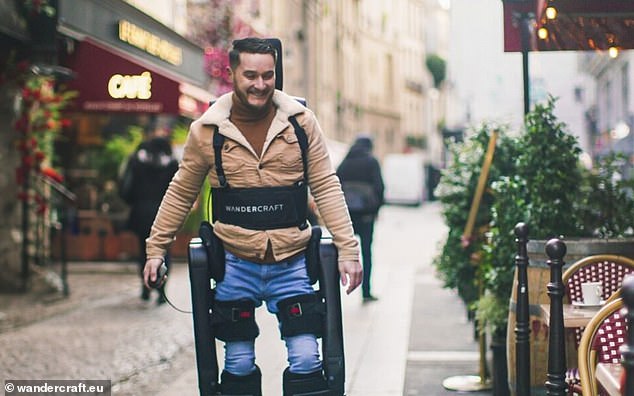Watch the heartwarming moment French Paralympian, Kevin Piette, who has been paraplegic since an accident at age 11, makes history as he carries the Olympic flame through Paris while wearing a robotic exoskeleton
- Tennis player carries the torch prior to the Olympics starting in Paris next month
- READ MORE: Incredible moment paralysed man walks for first time in 12 YEARS
A French Paralympian has been able to walk again – all thanks to a technology.
Tennis player Kevin Piette, 36, who lost the use of his legs in an accident aged 11, has made history by carrying the Olympic torch wearing a robotic exoskeleton.
Heartwarming footage shows him smiling as he passes waving crowds in Poissy, northwest Paris, as the traditional torch relay nears the end of its route.
X user @Brink_Thinker posted the clip, which has been described as 'inspirational' by fellow social media users.
Replying to the post, someone said: 'I have never seen a happier face!!!'

Kevin Piette, 36, who lost his use of his legs in an accident aged 11, is captured walking through the streets of Paris holding the Olympic torch
Another posted: 'So happy for him. You go. God bless technology.'
On Reddit, a user described it as 'amazing technology put to good use', while another simply called it 'inspirational'.
Another said: 'That’s amazing. Imagine when the exoskeletons get thinner and lighter.'
Someone else posted: '[This] is a big part of what the Olympics is about.
'Bringing people together, learning about each other, and sharing in victories of all kinds.'
In a blog post, the International Olympic Committee called Mr Piette 'the embodiment of sporting commitment'.
'In spite of the accident that left him a paraplegic 11 years ago, Kevin has not thrown in the towel,' it says.
'Instead, he returned to tennis as a para-athlete and became an exoskeleton "pilot" for a company developing a robotic walking device.
'By carrying the Olympic Torch, Kevin inspires people to get involved in sport and promote innovation for the disabled!'

On Reddit, a user described it as 'amazing technology put to good use', while another simply called it 'inspirational'

The personal exoskeleton, worn here in a promo shoot by Mr Piette, was developed by French company Wandercraft
Mr Piette is wearing the latest personal exoskeleton developed by French company Wandercraft, officially unveiled in New York in December.
The battery-powered exoskeleton supports the user's legs, allow users to sit, stand, walk around, climb stairs and navigate unfamiliar terrain.
A back sensor detects when the wearer wants to walk or stand, while a hand-held controller enables changes in direction and speeds.
As one of the first testers, Mr Piette has taken part in ‘cybathlons' – competitions where people with disabilities use assistive technologies to carry out everyday activities.
According to Wandercraft, this marks the first time a self-balancing personal exoskeleton has walked the Olympic torch relay while carrying a real wheelchair user.
The firm hopes the device 'will represent a significant leap forward in assistive technology' by becoming the first self-stabilizing walk exoskeleton in the market for personal everyday use.
'[It will enable] millions of individuals with walking disabilities to regain their mobility and move freely both at home and in their communities, enhancing their independence and sense of liberty and addressing health or well-being issues related to sedentary lifestyle,' it says.

The torch for the Paris 2024 Olympic Games was lit in ancient Olympia, Greece on April 16, 2024 (pictured)
The famous Olympic torch relay is a traditional event that precedes every Summer Olympics.
The torch is lit in Olympia, Greece – where the ancient Olympic games were held over 2,000 years ago – before gradually being transported to the host city.
It arrives in Paris before the start of the Summer Olympics opening ceremony this Friday (July 26).
Meanwhile, the Paralympics gets its own torch relay, albeit much shorter.
It will be lit in the English village of Stoke Mandeville – widely considered to be the birthplace of the Paralympic Games – on August 25 before making its way to Paris for the start of the Paralympics (August 28).
However, Mr Piette will not compete in the Paralympics this summer because he did not qualify, Wandercraft said.
















































































































































































































































